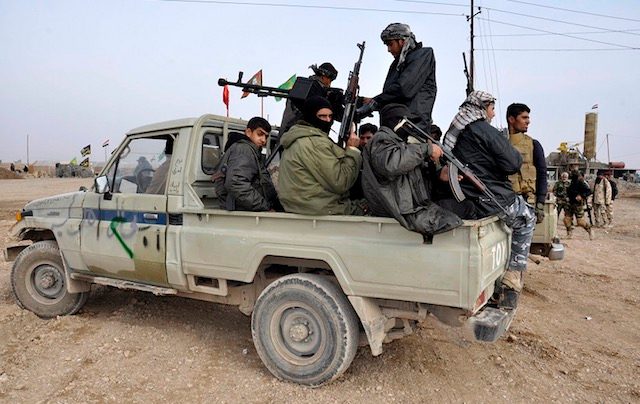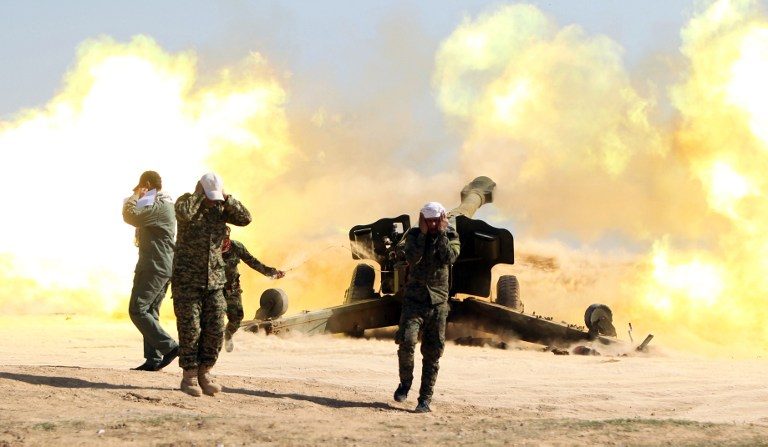SUMMARY
This is AI generated summarization, which may have errors. For context, always refer to the full article.

KIRKUK, Iraq – Iraqi forces closed in on Tikrit Tuesday, March 3, their progress slowed by jihadist snipers and booby traps, on the second day of Baghdad’s largest operation yet against the Islamic State (ISIS) group.
The government has mobilized a 30,000-strong force for the push to retake Tikrit made up of Shiite militiamen and Sunni tribesmen as well as troops and police.
Outnumbered and outgunned, the jihadists who have held Tikrit since June 2014 have been resorting to guerrilla tactics to disrupt the government’s advance.
“They are using urban warfare and snipers, so we are advancing in a cautious and delicate way, and we need more time,” a lieutenant general on the ground told Agence France-Presse.
Iraqi forces are moving on Tikrit from three directions, with units targeting the towns of Al-Alam and Ad-Dawr to the north and south, while another large contingent drives from the east.
“We are close to Ad-Dawr, but Daesh is still in the centre,” the senior officer said, using an Arabic acronym for ISIS.
Units were also moving from a variety of other directions, with military sources saying the plan was to encircle and besiege ISIS fighters in Tikrit.
The jihadist group announced in a radio bulletin Tuesday that a US national from its ranks had carried out a suicide attack against Iraqi forces near Samarra, the other main city in Salaheddin province.
The attacker was referred to by his nom de guerre, Abu Dawud al-Amriki. The group released a picture purportedly of him, wearing a mask that only reveals a pair of dark eyes.
Revenge for storage
The operation, the government’s largest since it started attempting to regain the ground it lost to jihadists last summer, was announced Sunday, March 1, by Prime Minister Haider al-Abadi.
Both Iraqi and Iranian media said Qassem Soleimani – the commander of the Al-Quds Force covert operations unit of Tehran’s elite Revolutionary Guards – was in Salaheddin province to help coordinate operations.
The recapture of Tikrit is of both strategic and symbolic importance.
Located about 160 kilometers (100 miles) north of Baghdad, it is the hometown of former president Saddam Hussein, the remnants of whose Baath party have collaborated with ISIS.
Commanders have said Tikrit is a stepping stone for an even more ambitious operation aimed at retaking Mosul, the large northern city which has been the main Iraq hub of ISIS.
The battle for Tikrit, which the government has already tried and failed to retake several times, is seen as a test of how effectively such diverse fighting units work together.
“The battle for Tikrit and other towns in Salaheddin province will provide a mini-preview of what awaits further to the north in Mosul,” said the Soufan Group intelligence consultancy.
Tikrit and its surroundings are Sunni and some tribes have been accused of involvement in the massacre of hundreds of new, mostly Shiite, recruits at the nearby base called Speicher in June.

Some leaders, including the powerful head of Iraq’s Popular Mobilisation units Hadi al-Ameri, have explicitly said the Tikrit operation would be an opportunity to exact revenge.
The UN warned that operations “must be conducted with the utmost care to avoid civilian casualties, and with full respect for fundamental human rights principles and humanitarian law.”
General Martin Dempsey, chairman of the US Joint Chiefs of Staff, said Iran’s military assistance in the Tikrit offensive could be positive as long as it did not fuel sectarian divisions.
“This is the most overt conduct of Iranian support,” Dempsey told senators, which came “in the form of artillery” and other aid.
“Frankly, it would only be a problem if it resulted in sectarianism,” he said.
Dempsey said Shiite militia – which are armed by Tehran – account for about two-thirds of the force while Iraqi government army troops make up the remainder.
No Mosul timeline
A senior US defense official had suggested last month that the Mosul offensive should begin in April or May, a move that irked Iraqi commanders who argued the timing was theirs to decide.
On Monday, March 2, US President Barack Obama’s envoy for the fight against IS stressed there was no timeline.
“The point about Mosul, or the point about any aspect of the counter-offensive, is less about the timing than about the preparation,” John Allen said.
Australia announced Tuesday it will send another 300 troops to Iraq in a joint mission with New Zealand to help prepare Iraqi forces for the fightback.
And two cargo planes of Turkish military aid landed in Baghdad Tuesday, a sign of Ankara’s apparently increasing willingness to help tackling ISIS.
Allen said that preparation was not just military but should also include measures to assist the affected population.
Tents have been set up in Samarra to shelter civilians fleeing Tikrit and joining what the International Organization for Migration says are 2.5 million people already displaced in Iraq. – Rappler.com
Add a comment
How does this make you feel?
There are no comments yet. Add your comment to start the conversation.